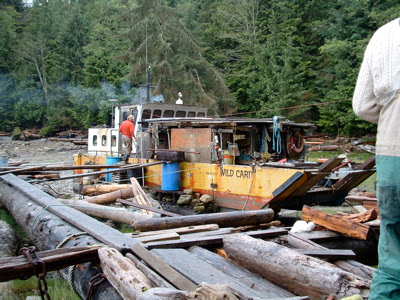

Reduce, Reuse, Recycle: The Hermit of Nameless Bay
At first glance it might seem odd to be writing of one who has chosen to live alone in a section entitled: Sustainable Community. But the hermits of the
Ed Zeemel first came to the Coast in 1969, having finished a 5-year hitch in the navy. Like hundreds of other young people that summer, he was drawn to the rolling surf and shining sands of
While operating a new and used tool store in North Van in the early ‘90s, Ed purchased the motor barge Wild Card. In 1996 he headed north, back to the inlets he loved. Anchoring for the night in the “unnamed bay” east of Tuna Point and north of
Wild Card needed some work on her bottom. Hauling in some timbers he had found on the beach around the corner, Ed constructed a cradle. She felt pretty good up on the high-tide line, except when the cruise ships went by in
Ed discovered that if he did a little bit, nature would do a lot, instructing him as he went along. He took out the downed trees and branches, opening up the forest so that the berry bushes would grow. He filled the holes with forest debris and driftwood from the beach, leveling off areas where you can grow a bit of garden, split some wood, sort and store “gifts from the sea,” or just sit in the early morning or late evening sun. A park-like atmosphere emerged. He dug out the side of a cliff to form a grotto, with a spring-like pool to provide fresh water.
Ed lives alone but never lonely. His neighbours are the otters, the black bears, the birds and the deer. “Mostly we get along,” Ed says. “But like all good neighbours, we have to respect each other’s space. I’m not adverse to putting a pellet from my air rifle into a young bear’s backside when he insists on stealing my apples. One time I cored an apple and filled it with hot pepper. Didn’t see that bear around for a while after that!”
In his projects, Ed uses the wealth of material that floats by his bay or washes up in the southeast gales. “There’s always a use for something,” Ed says. “If not now, later.”
Some hermits desire privacy and appreciate others respecting that. Not so Ed Zeemel. One of his projects is to carve out kayaker camping spots above the tide line in his bay. Another project, using driftwood from the beach and brush from the forest, is to reclaim the eroded shoreline so that grass will grow again. “If the grass comes back, so will the geese,” Ed says. “And if the geese come back, I will die a happy man.”
 Compost, seaweed and a little rock re-arranging for Ed's rich garden beds.
Compost, seaweed and a little rock re-arranging for Ed's rich garden beds. The mysterious "O" gardens.
The mysterious "O" gardens.
Last time we visited
Once there was so much activity at
With all this history of former community life, including the centuries of large populations of Native people, it was heartbreaking to hear that the dismal, crumbling bankrupt remains had gone to some millionaire for a private resort.
Minstrel dock in 2005
IMAGINE OUR SURPRISE when we met people from
You can see the wharfinger dog doing his rounds. They came down to say goodby as we left.
Right now we have this feeling of life coming back to the central coast. We enjoyed meeting Chris and Chris, who are restoring the 100 year-old tug Swan in Billy’s cove. They have gotten involved in the Egmont community and plan to live aboard Swan. We saw the guy on Gospak who helped us right La Sonrisa when she fell over on the tidal grid at Port McNeil a few years ago. He was tied to a string of float shacks, building a new one. And hermit Ed of Nameless Bay had a float shack and former kayak camp float tied up in his cove. Feels like people are finding new energy.





1 comment:
Hey guys
that bathtub looks a lot like ours ... I hadn't thought of moving it outside for the summer, but the idea is tempting now that the birds are returning! We just need a 'slightly' secluded spot....
Fran & Peter
Post a Comment